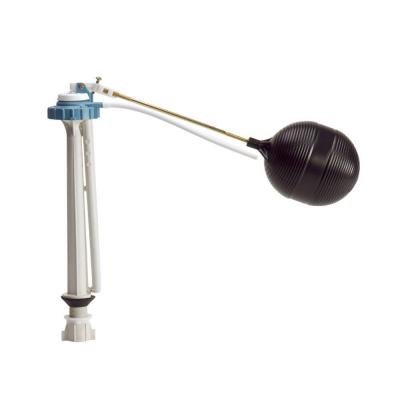Hello anyone who may be able to help:
We have a 1985 Eljer Triangle Toilet. The fill valve finally gave it up, after 30 years, and we replaced the fill valve with a Coast Mark IV 1B1 Master fill valve (part # 495-0214-00) that is supposed to be the correct ballcock fill valve for this toilet. After adjusting the fill valve cut off to where it should be (measuring from the tank fill line and the overflow tube) we have this issue: after flushing the toilet the tank fills to the appropriate level and shuts off; in roughly 15 seconds, the fill valve opens again for 2 seconds then shuts off, then 5 sconds later the fill valve opens again and shuts off. This happens a total of 4 times after the initial flush and fill. The level of the tank water remains the same after the 4th fill valve turn on until the next time we flush the toilet. Then it repeats the same scenario again. We thought it was a bad fill valve so we put another new fill valve in (same model fill valve) and it does the same thing. The water level in the bowl doesn't seem to fluctuate at all during these additional fill valve openings. Could turbulence in the tank be affecting the float ball? Is this a leaking flapper issue? Is this due to too much water pressure? We don't want to go through the hassle of replacing the whole toilet because we're not sure the soil line is the appropriate distance from the walls to accommodate a standard toilet & we have a ceramic tile floor in the bathroom. We haven't put the lid on our toilet tank for the past 9 months and this issue and toilet are really grating on our last nerve. Any insight on how to fix this would be greatly appreciated.
Trying to be a self-sufficient girldog.
girldog, May 2, 2015EditReport
Reply
We have a 1985 Eljer Triangle Toilet. The fill valve finally gave it up, after 30 years, and we replaced the fill valve with a Coast Mark IV 1B1 Master fill valve (part # 495-0214-00) that is supposed to be the correct ballcock fill valve for this toilet. After adjusting the fill valve cut off to where it should be (measuring from the tank fill line and the overflow tube) we have this issue: after flushing the toilet the tank fills to the appropriate level and shuts off; in roughly 15 seconds, the fill valve opens again for 2 seconds then shuts off, then 5 sconds later the fill valve opens again and shuts off. This happens a total of 4 times after the initial flush and fill. The level of the tank water remains the same after the 4th fill valve turn on until the next time we flush the toilet. Then it repeats the same scenario again. We thought it was a bad fill valve so we put another new fill valve in (same model fill valve) and it does the same thing. The water level in the bowl doesn't seem to fluctuate at all during these additional fill valve openings. Could turbulence in the tank be affecting the float ball? Is this a leaking flapper issue? Is this due to too much water pressure? We don't want to go through the hassle of replacing the whole toilet because we're not sure the soil line is the appropriate distance from the walls to accommodate a standard toilet & we have a ceramic tile floor in the bathroom. We haven't put the lid on our toilet tank for the past 9 months and this issue and toilet are really grating on our last nerve. Any insight on how to fix this would be greatly appreciated.
Trying to be a self-sufficient girldog.
girldog, May 2, 2015EditReport
Reply
Last edited by a moderator:

